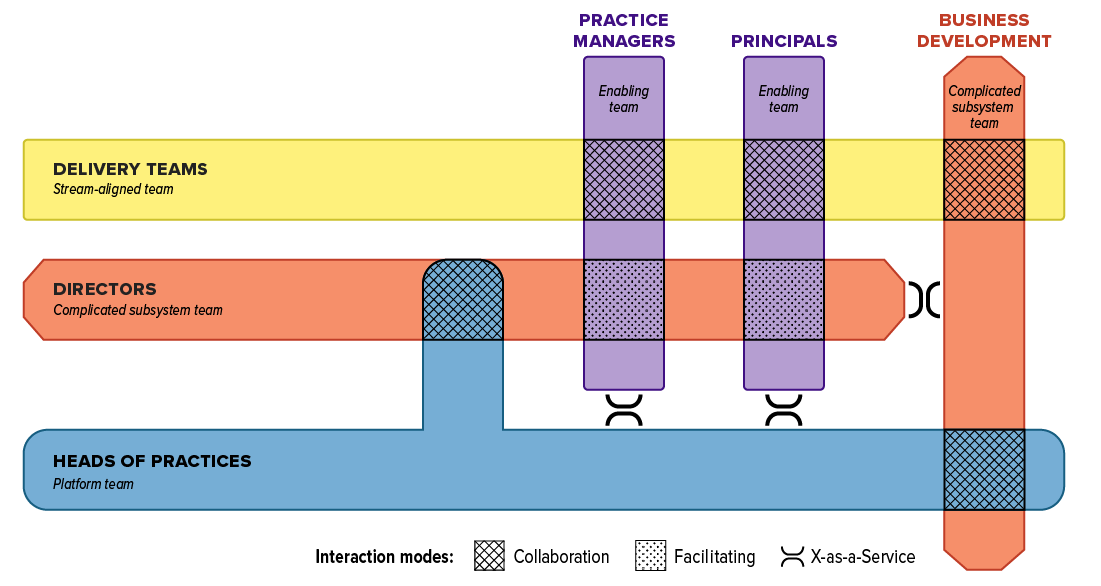When I arrived at Ad Hoc a few months ago as the new VP of Engineering, one of my first responsibilities was to roll out new leadership levels within our fast-growing Engineering team that help us scale effectively.
We recently wrote about one of these leadership additions, practice managers, and how important it is to be intentional about change when it comes to organizational design. Since then, we’ve also introduced new Engineering Directors to the organization.
Adding new leadership levels can have a ripple effect across the entire company. Their roles need to be clear and the rest of the organization has to be able to interface with them effectively. In the spirit of continuing to be intentional about change, in this blog post I’ll dive deep into how the introduction of our new role, Engineering Directors, was an opportunity to refresh how Engineering communicates across the organization so that we are optimized for fast, efficient information flow. We needed to reimagine how communications and information would flow through this new leadership level.
Being loosely coupled and highly aligned
Growing companies often simply segment off sub-groups under a senior lead as a way to introduce a new level to the org. They “empower” the new group managers by simply handing over existing day-to-day management responsibilities for that area with instructions to “stay in your lane,” and “keep me up to date on progress.”
Pretty quickly, this results in multiple different organizational silos, all operating differently, and an overburdened senior leader trying to coordinate everything. These silos require that information flow up, over, and down the other silos to achieve any aligned focus.
When we set out to evolve Engineering leadership, we wanted to ensure we weren’t creating silos with these new roles. So, we embraced the concept of “teams” and applied this toward the leadership level. We began to think about our team topologies as layers of topologies.
What if our Engineering Directors acted as a single unified team with a clear mission and goals? Could we build a team where they worked together to resolve challenges, developed aligned agreements where needed, and craft a common way of interacting within the organization that could be counted on? And could we do this while also giving them high autonomy to work within their area of focus the way they needed to?
Many companies over-optimize in order to “avoid the silo” to the point that everyone is in every discussion. Fred Brooks, in his book The Mythical Man Month, calculated the number of communication pathways within a team as [n * (n-1)]/2. So for a team of 5 you have 10 communication pathways and a team of 12 will have a whopping 66 communication pathways.

A meeting with 12 people is likely not to be collaborative. A small number of people will talk, and a large number of people will observe the dialogue (or zone out). While this might help with information dissemination, all 12 people are NOT likely to leave this verbal discussion with the same understanding of (1) the decisions made, and (2) the required next steps.
Conway’s Law dictates that companies will design teams (and systems) that are copies of the communication structures of the organization. If an organization is not intentional about optimizing communication pathways to increase alignment and reduce cognitive load, the organization will suffer as a result of this haphazard org design. As the size and complexity of an organization increases, there is a point where the existing organizational design no longer supports the two most important facets of organizational effectiveness:
- Fast, effective flow of information
- Informed decision-making
We can either fall prey to the ineffective inertia of siloes, create mass coordination nightmares, OR we learn to use Conway’s law to our advantage. If Conway’s Law dictates that communication paths follow organizational design, then an organization that wants to optimize for fast, effective flow needs to ensure that team and organizational structures support the communication flow that they desire. This is called the inverse Conway maneuver.
To be both loosely coupled and highly aligned, we would need to be intentional in how we crafted our interactions with our teams, each other, and across the organization.
Defining a clear leadership team topology
As an engineering leader, I have always focused on building loosely coupled and highly aligned teams because my experience over the years has proven that they’re more effective. Highly effective teams have clear responsibilities, well-defined boundaries, and are highly accountable for their actions and outcomes. This structure also ensures that the cognitive load between teams can be more easily managed. Effective teams can manage a small set of internal communication pathways as they self-organize; then they can define clear working agreements externally for how they interact with other teams.
Matthew Skelton and Manuel Pais, authors of Team Topologies, examine how to implement this inverse Conway maneuver to build cohesive delivery team structures with clear boundaries and loose coupling. Many software engineering organizations have recrafted their organizational structures using the learnings from Team Topologies, and, if the 2021 State of DevOps Report is any indication, loosely coupled and highly aligned teams are here to stay.
If you haven’t read the Team Topologies book, it prescribes four fundamental team types:
- A stream-aligned team has end-to-end responsibility for an entire value stream
- An enabling team temporarily helps other teams to get up to speed when they need it
- A complicated subsystem team wraps unique, hard-to-find skills inside one team
- A platform team offers infrastructure or architecture — acting as a supplier
The Team Topologies framework is used most often to organize software development teams, but what if the insights from Team Topologies weren’t just reserved for development teams? What if this framework could be applied to any type of team, at any level of an organization? We endeavored to find out.
If we want to build loosely coupled and highly aligned leadership teams, we would need to model how we desired communication to flow across our organization and needed to ensure we were creating leadership teams that reduced the cognitive load for everyone. We first needed to look at what our leadership teams were, and how they went together.

Here are the leadership teams we modeled and how we approached this.
Delivery teams
As a government digital consultancy, the work we do for our customers needs to deliver positive outcomes fast and effectively. This work, on digital properties like HealthCare.gov and VA.gov, delivers critical services to the people of our country. Our customer delivery teams are our stream-aligned teams; they need to retain focus and continue to increase effectiveness. These teams own end-to-end value creation.
Practice managers
The introduction of practice managers enables our practitioners to evolve their craft more quickly and effectively. One might see these practice managers as simply a hierarchy of individuals, but we see them, collectively, as an enabling team. When we combine the practice manager coaching with our continuing education stipend, our practitioners get the full support they need to continue to grow their craft.
Principals
Like many consultancies, we also have Principals. Principals are those most senior practitioners who play key roles for our customers and within our delivery teams. Principals architect, evolve, and adapt systems, teams, and relationships within their area of influence. As the most senior practitioners, they have largely mastered their craft, are subject matter experts in an area, and they use this knowledge to steer our delivery teams toward positive outcomes.
Our Principals move among our stream-aligned teams and assist them, as needed, with complex challenges. Principals act as an enabling team by working together, across the organization, to grow the maturity level of our delivery teams and work to more closely align our teams toward the philosophy of how we work that has made Ad Hoc so sought after as a partner to our government customers.
Directors
As a fast growing organization, there is complexity from team formation all the way through to maturing a delivery program. Our Directors assist our teams to move quickly through the team maturity phases of forming, storming, norming, and performing. Our Directors provide the tools, instrumentation, and coaching necessary to strengthen our teams. They also need to be strong leadership coaches themselves to advise and support practice managers and principals within their area of focus.
Our directors are also the glue that works with both customer-facing delivery teams and business development teams to ensure that new work we bid on can be successfully delivered by our teams. This triad needs to build strong relationships with each other and continue to nurture overall growth. Our Directors act as a complicated subsystem team to provide the foundational leadership infrastructure which successfully connects and mobilizes these teams in a clear direction.
Heads of practice areas
The strategic heads of each practice area (engineering, product, design, research) are the team who is architecting our direction. This team cultivates the philosophy of how we work as an organization, the values we hold, the capabilities we bring to the table, and the services we provide to our customers. We’re the strategic thought leaders.
We observe the challenges that our government is faced with, and we develop new strategies and capabilities to bring positive outcomes to those challenges. The heads of our practice areas lay the foundation, as a platform team, which all other teams will leverage to deliver on the value we bring to our customers. Our heads of practice deliver strategy to our directors who activate it in the field. They also work collaboratively with our business development team to develop new capabilities that we can bring to government digital services.
Putting the leadership team topology into action
Beginning to define how our leadership teams interact with each other has been a powerful exercise. It supports our ability to have the right conversations with the right teams. And it has given us a clear framework by which we can flow information, and decision making, from one area to another.
Each leadership team is becoming more clear on their mission, and is understanding more clearly what they can expect from each other. When teams know what is expected of them, and they receive clear consistent guidance, they can feel empowered to act in alignment with their charter and mission. This strengthens the trust that each team has in each other to do their part to implement, extend, and act in alignment to the Ad Hoc mission overall.
As people within Engineering take on new responsibilities, and new people join our teams, they are entering an intentionally-structured way of operating. They know who in the organization they are meant to collaborate with, and they’re developing a stronger understanding of what level of interaction is expected.
While this work is still underway in Ad Hoc Engineering, the benefits are starting to show. We’re looking forward to seeing how this plays out over the next few quarters as we put it fully into action.
If this sounds like the kind of organizational structure you’d like to work within, we have roles open across the company. Find your place on the Ad Hoc team.


